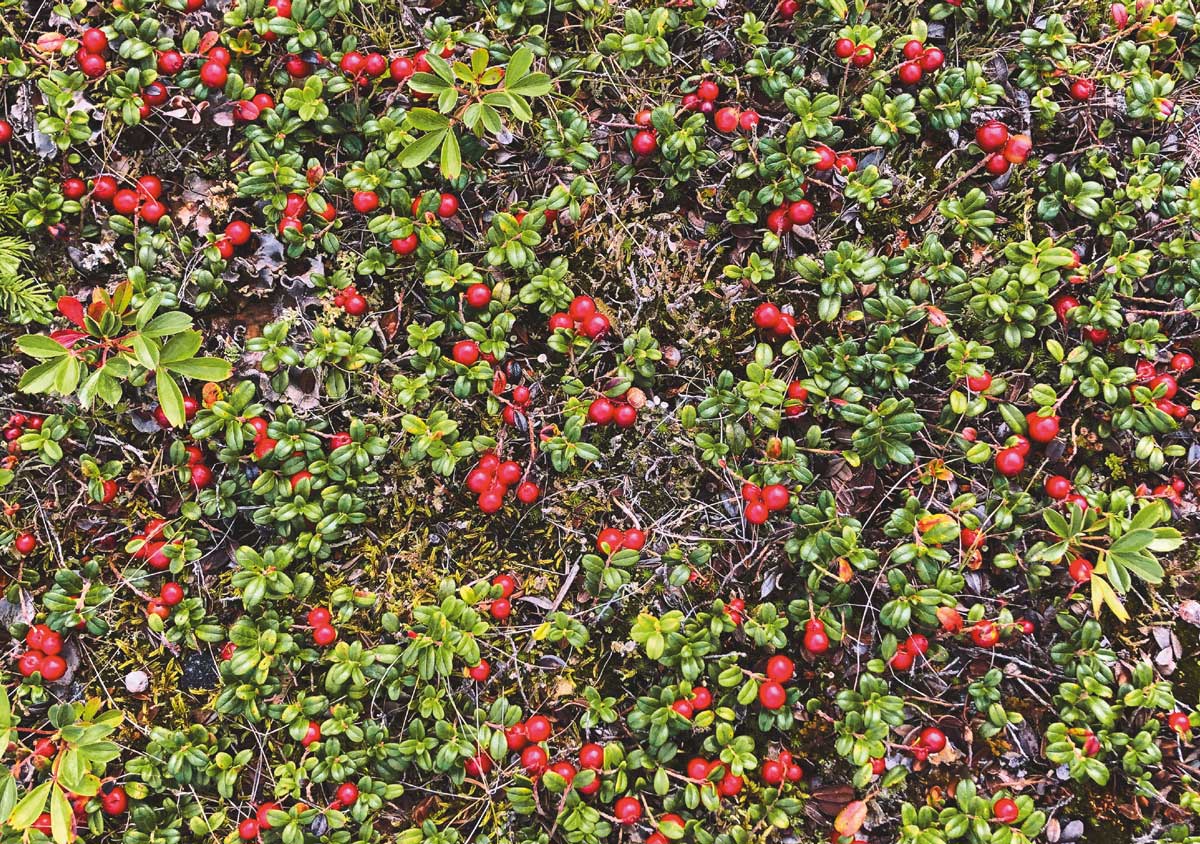On the North Shore, locals hunt for red berries or mountain berries. Elsewhere, Vaccinium vitis-idaea is commonly called partridgeberry or mountain cranberry; in Scandinavia, where it is well loved, it’s lingonberry. But this fruit by any other name would taste as tart: no matter what you call it, on the North Shore, everyone knows just how good the red berry is.
BY VIRGINIE LANDRY
In early October, families head out to pick redberries, a tradition passed down from the local Innu people. Joyce Dominique, a journalist for the Innu radio station CKAU in Uashat mak Mani-utenam, says, “Harvest season is a time for intergenerational gatherings and celebrations.” Everyone heads to the forest to find “their” berry patch, the one that returns year after year, and gather the fruit by hand. An even shade of red indicates that the berries are ripe; they can then be easily removed from their stems.
A first frost improves the fruit’s taste and enhances its sweetness, removing traces of bitterness. The cold allows its subtle flavour to shine through.
The Innu also pick red berries in the wintertime. They cover the bushes with blankets before the first snow, removing them during the cold months to pick the unspoiled fruits underneath. In this way, the berries can be consumed year-round.
Mario Noël, who owns the Puyjalon Distillery in Havre-Saint-Pierre, adds that many locals have a patch in their very own yard: “My father-in-law has some on his land and supplies lots of neighbours. The red berry is part of our local culture and family histories.”
Some turn the hand-picked fruits into jam; others add them to muffins or cakes. Red berries can also be eaten whole, slightly warm and spread onto fresh bread. Mario Noël loves to add them to his onion confit.
Joyce Dominique adds that some Innu add them to bannock, a traditional Indigenous bread. In the past, she says, “elders would heat fresh-picked berries with bear grease, then let the mixture cool. It was considered a luxury dessert.”
Because red berries reputedly possess antiviral properties, the Innu dry the leaves and fruits to brew them into an herbal tea that is used to fight sore throats, prevent mouth and urinary tract infections, and maintain kidney health.
Experiments in small-scale cultivation
A Nordic fruit that grows on a hardy shrub, the red berry shares family ties with the cranberry. The two berries are similar in taste, colour and nutritional profile. Red berries are antioxidant-rich and treasured by local communities for their tart flavour.
The red berry isn’t currently produced on a large scale on the North Shore, but it is the subject of artisanal and, more recently, experimental cultivation. For the past three years, the Centre d’expérimentation et de développement en forêt boréale (CEDFOB), a Baie-Comeau research centre focused on boreal forest products, has been exploring the berries’ potential with local small-scale producers.
Ève-Catherine Desjardins, a researcher with the CEDFOB, says this interest stems from a desire to “diversify fruit cultivation on the North Shore and stand out on the provincial scene.” Through test protocols in both a natural setting and in the lab, the CEDFOB is trying to determine whether the red berry could be cultivated on a larger scale. “We are still in the research phase, but things are going well,” she says.
A berry for eating and drinking
A few North Shore businesses offer artisanal products made with the versatile red berry. Les Délices de Michèle, a small confectionary in Colombier, makes red berry jams and chocolates.
The Puyjalon Distillery transforms the berries into a refined gin liqueur. Mario Noël macerates the fruit in gin before adding sugar to create this exceptional tipple. The result is “a striking red, flavourful liqueur.” Rubis Nordique is sold at the Distillery and in the SAQ.
The distillery is also planning to develop microbrewed beers using the macerated fruits leftover from gin production.
If the CEDFOB research succeeds in increasing red berry production, there’s a very good chance we’ll find the delicious fruit in a wide variety of new products in the years to come.
le Goût de la Côte-Nord magazine
June 2022 – Number 2

To learn more about the Côte-Nord terroir, get le Goût de la Côte-Nord magazine!




